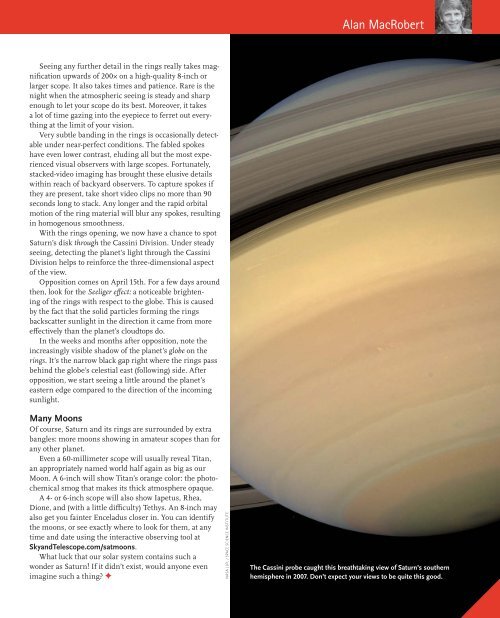Download this ebook as PDF - E-Book Library
Download this ebook as PDF - E-Book Library
Download this ebook as PDF - E-Book Library
Create successful ePaper yourself
Turn your PDF publications into a flip-book with our unique Google optimized e-Paper software.
Seeing any further detail in the rings really takes magnifi<br />
cation upwards of 200× on a high-quality 8-inch or<br />
larger scope. It also takes times and patience. Rare is the<br />
night when the atmospheric seeing is steady and sharp<br />
enough to let your scope do its best. Moreover, it takes<br />
a lot of time gazing into the eyepiece to ferret out everything<br />
at the limit of your vision.<br />
Very subtle banding in the rings is occ<strong>as</strong>ionally detectable<br />
under near-perfect conditions. The fabled spokes<br />
have even lower contr<strong>as</strong>t, eluding all but the most experienced<br />
visual observers with large scopes. Fortunately,<br />
stacked-video imaging h<strong>as</strong> brought these elusive details<br />
within reach of backyard observers. To capture spokes if<br />
they are present, take short video clips no more than 90<br />
seconds long to stack. Any longer and the rapid orbital<br />
motion of the ring material will blur any spokes, resulting<br />
in homogenous smoothness.<br />
With the rings opening, we now have a chance to spot<br />
Saturn’s disk through the C<strong>as</strong>sini Division. Under steady<br />
seeing, detecting the planet’s light through the C<strong>as</strong>sini<br />
Division helps to reinforce the three-dimensional <strong>as</strong>pect<br />
of the view.<br />
Opposition comes on April 15th. For a few days around<br />
then, look for the Seeliger eff ect: a noticeable brightening<br />
of the rings with respect to the globe. This is caused<br />
by the fact that the solid particles forming the rings<br />
backscatter sunlight in the direction it came from more<br />
eff ectively than the planet’s cloudtops do.<br />
In the weeks and months after opposition, note the<br />
incre<strong>as</strong>ingly visible shadow of the planet’s globe on the<br />
rings. It’s the narrow black gap right where the rings p<strong>as</strong>s<br />
behind the globe’s celestial e<strong>as</strong>t (following) side. After<br />
opposition, we start seeing a little around the planet’s<br />
e<strong>as</strong>tern edge compared to the direction of the incoming<br />
sunlight.<br />
Many Moons<br />
Of course, Saturn and its rings are surrounded by extra<br />
bangles: more moons showing in amateur scopes than for<br />
any other planet.<br />
Even a 60-millimeter scope will usually reveal Titan,<br />
an appropriately named world half again <strong>as</strong> big <strong>as</strong> our<br />
Moon. A 6-inch will show Titan’s orange color: the photochemical<br />
smog that makes its thick atmosphere opaque.<br />
A 4- or 6-inch scope will also show Iapetus, Rhea,<br />
Dione, and (with a little diffi culty) Tethys. An 8-inch may<br />
also get you fainter Enceladus closer in. You can identify<br />
the moons, or see exactly where to look for them, at any<br />
time and date using the interactive observing tool at<br />
SkyandTelescope.com/satmoons.<br />
What luck that our solar system contains such a<br />
wonder <strong>as</strong> Saturn! If it didn’t exist, would anyone even<br />
imagine such a thing? ✦<br />
NASA / JPL / SPACE SCIENCE INSTITUTE<br />
Alan MacRobert<br />
Alan MacRobert<br />
The C<strong>as</strong>sini probe caught <strong>this</strong> breathtaking view of Saturn’s southern<br />
hemisphere in 2007. Don’t expect your views to be quite <strong>this</strong> good.


